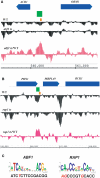Extensive role of the general regulatory factors, Abf1 and Rap1, in determining genome-wide chromatin structure in budding yeast
- PMID: 21081559
- PMCID: PMC3064788
- DOI: 10.1093/nar/gkq1161
Extensive role of the general regulatory factors, Abf1 and Rap1, in determining genome-wide chromatin structure in budding yeast
Abstract
The packaging of eukaryotic DNA into chromatin has profound consequences for gene regulation, as well as for other DNA transactions such as recombination, replication and repair. Understanding how this packaging is determined is consequently a pressing problem in molecular genetics. DNA sequence, chromatin remodelers and transcription factors affect chromatin structure, but the scope of these influences on genome-wide nucleosome occupancy patterns remains uncertain. Here, we use high resolution tiling arrays to examine the contributions of two general regulatory factors, Abf1 and Rap1, to nucleosome occupancy in Saccharomyces cerevisiae. These factors have each been shown to bind to a few hundred promoters, but we find here that thousands of loci show localized regions of altered nucleosome occupancy within 1 h of loss of Abf1 or Rap1 binding, and that altered chromatin structure can occur via binding sites having a wide range of affinities. These results indicate that DNA-binding transcription factors affect chromatin structure, and probably dynamics, throughout the genome to a much greater extent than previously appreciated.
Figures






Similar articles
-
Comparison of ABF1 and RAP1 in chromatin opening and transactivator potentiation in the budding yeast Saccharomyces cerevisiae.Mol Cell Biol. 2004 Oct;24(20):9152-64. doi: 10.1128/MCB.24.20.9152-9164.2004. Mol Cell Biol. 2004. PMID: 15456886 Free PMC article.
-
Genome-wide analysis of transcriptional dependence and probable target sites for Abf1 and Rap1 in Saccharomyces cerevisiae.Nucleic Acids Res. 2007;35(1):193-202. doi: 10.1093/nar/gkl1059. Epub 2006 Dec 7. Nucleic Acids Res. 2007. PMID: 17158163 Free PMC article.
-
Genome-wide determinants of sequence-specific DNA binding of general regulatory factors.Genome Res. 2018 Apr;28(4):497-508. doi: 10.1101/gr.229518.117. Epub 2018 Mar 21. Genome Res. 2018. PMID: 29563167 Free PMC article.
-
Multiple roles of the general regulatory factor Abf1 in yeast ribosome biogenesis.Curr Genet. 2017 Feb;63(1):65-68. doi: 10.1007/s00294-016-0621-3. Epub 2016 Jun 4. Curr Genet. 2017. PMID: 27262581 Review.
-
Establishing nucleosome architecture and stability at promoters: Roles of pioneer transcription factors and the RSC chromatin remodeler.Bioessays. 2017 May;39(5). doi: 10.1002/bies.201600237. Epub 2017 Mar 27. Bioessays. 2017. PMID: 28345796 Review.
Cited by
-
Epigenome characterization at single base-pair resolution.Proc Natl Acad Sci U S A. 2011 Nov 8;108(45):18318-23. doi: 10.1073/pnas.1110731108. Epub 2011 Oct 24. Proc Natl Acad Sci U S A. 2011. PMID: 22025700 Free PMC article.
-
Mapping yeast transcriptional networks.Genetics. 2013 Sep;195(1):9-36. doi: 10.1534/genetics.113.153262. Genetics. 2013. PMID: 24018767 Free PMC article. Review.
-
Correspondence: Reply to 'DNA shape is insufficient to explain binding'.Nat Commun. 2017 Jun 5;8:15644. doi: 10.1038/ncomms15644. Nat Commun. 2017. PMID: 28580953 Free PMC article. No abstract available.
-
Epigenetic pioneering by SWI/SNF family remodelers.Mol Cell. 2024 Jan 18;84(2):194-201. doi: 10.1016/j.molcel.2023.10.045. Epub 2023 Nov 27. Mol Cell. 2024. PMID: 38016477 Free PMC article. Review.
-
Sophisticated Conversations between Chromatin and Chromatin Remodelers, and Dissonances in Cancer.Int J Mol Sci. 2021 May 25;22(11):5578. doi: 10.3390/ijms22115578. Int J Mol Sci. 2021. PMID: 34070411 Free PMC article. Review.
References
-
- Owen-Hughes T, Workman JL. Experimental analysis of chromatin function in transcription control. Crit. Rev. Eukaryot. Gene Expr. 1994;4:403–441. - PubMed
-
- Simpson RT. Nucleosome positioning: occurrence, mechanisms, and functional consequences. Prog. Nucleic Acid Res. Mol. Biol. 1991;40:143–184. - PubMed
-
- Thoma F. Nucleosome positioning. Biochim. Biophys. Acta. 1992;1130:1–19. - PubMed
-
- Hirschhorn JN, Brown SA, Clark CD, Winston F. Evidence that SNF2/SWI2 and SNF5 activate transcription in yeast by altering chromatin structure. Genes Dev. 1992;6:2288–2298. - PubMed
Publication types
MeSH terms
Substances
Grants and funding
LinkOut - more resources
Full Text Sources
Other Literature Sources
Molecular Biology Databases

